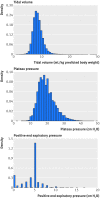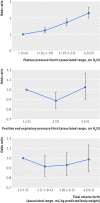Intraoperative protective mechanical ventilation and risk of postoperative respiratory complications: hospital based registry study
- PMID: 26174419
- PMCID: PMC4501577
- DOI: 10.1136/bmj.h3646
Intraoperative protective mechanical ventilation and risk of postoperative respiratory complications: hospital based registry study
Abstract
Objective: To evaluate the effects of intraoperative protective ventilation on major postoperative respiratory complications and to define safe intraoperative mechanical ventilator settings that do not translate into an increased risk of postoperative respiratory complications.
Design: Hospital based registry study.
Setting: Academic tertiary care hospital and two affiliated community hospitals in Massachusetts, United States.
Participants: 69,265 consecutively enrolled patients over the age of 18 who underwent a non-cardiac surgical procedure between January 2007 and August 2014 and required general anesthesia with endotracheal intubation.
Interventions: Protective ventilation, defined as a median positive end expiratory pressure (PEEP) of 5 cmH2O or more, a median tidal volume of less than 10 mL/kg of predicted body weight, and a median plateau pressure of less than 30 cmH2O.
Main outcome measure: Composite outcome of major respiratory complications, including pulmonary edema, respiratory failure, pneumonia, and re-intubation.
Results: Of the 69,265 enrolled patients 34,800 (50.2%) received protective ventilation and 34,465 (49.8%) received non-protective ventilation intraoperatively. Protective ventilation was associated with a decreased risk of postoperative respiratory complications in multivariable regression (adjusted odds ratio 0.90, 95% confidence interval 0.82 to 0.98, P=0.013). The results were similar in the propensity score matched cohort (odds ratio 0.89, 95% confidence interval 0.83 to 0.97, P=0.004). A PEEP of 5 cmH2O and median plateau pressures of 16 cmH2O or less were associated with the lowest risk of postoperative respiratory complications.
Conclusions: Intraoperative protective ventilation was associated with a decreased risk of postoperative respiratory complications. A PEEP of 5 cmH2O and a plateau pressure of 16 cmH2O or less were identified as protective mechanical ventilator settings. These findings suggest that protective thresholds differ for intraoperative ventilation in patients with normal lungs compared with those used for patients with acute lung injury.
© Ladha et al 2015.
Conflict of interest statement
Competing interests: All authors have completed the ICMJE uniform disclosure form at
Figures



Comment in
-
Importance of "default" intraoperative ventilator settings.BMJ. 2015 Sep 30;351:h5125. doi: 10.1136/bmj.h5125. BMJ. 2015. PMID: 26423454 No abstract available.
-
Authors' reply to Whitlock and Saied and colleagues.BMJ. 2015 Sep 30;351:h5143. doi: 10.1136/bmj.h5143. BMJ. 2015. PMID: 26424610 No abstract available.
-
Intraoperative protective ventilation: too early to redefine management parameters?BMJ. 2015 Sep 30;351:h5126. doi: 10.1136/bmj.h5126. BMJ. 2015. PMID: 26424717 No abstract available.
References
-
- Nunn JF, Payne JP. Hypoxaemia after general anaesthesia. Lancet 1962;2:631-2. - PubMed
-
- Bendixen HH, Hedley-Whyte J, Laver MB. Impaired oxygenation in surgical patients during general anesthesia with controlled ventilation. A concept of atelectasis. N Engl J Med 1963;269:991-6. - PubMed
-
- Amato MB, Barbas CS, Medeiros DM, Magaldi RB, Schettino GP, Lorenzi-Filho G, et al. Effect of a protective-ventilation strategy on mortality in the acute respiratory distress syndrome. N Engl J Med 1998;338:347-54. - PubMed
-
- Acute Respiratory Distress Syndrome Network. Ventilation with lower tidal volumes as compared with traditional tidal volumes for acute lung injury and the acute respiratory distress syndrome. N Engl J Med 2000;342:1301-8. - PubMed
-
- Dimick JB, Chen SL, Taheri PA, Henderson WG, Khuri SF, Campbell DA. Hospital costs associated with surgical complications: a report from the private-sector National Surgical Quality Improvement Program. J Am Coll Surg 2004;199:531-7. - PubMed
Publication types
MeSH terms
Grants and funding
LinkOut - more resources
Full Text Sources
Other Literature Sources
Medical
